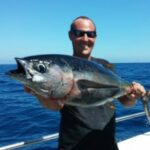Best Surf Fishing Rigs: Basic, Fish Finder, Hi-Lo, Breakaway

Fishing in the surf, either dry, from the beach while wearing polaroid glasses; or waist deep in waders, before the surf line (to give you a little longer reach), is one of the most satisfying sunrise to sunset fishing sessions for me. The smell of the ocean, the light on the water, the surge on line, and the best surf fishing rod; all make for an extremely satisfying fishing experience.
The secret to a good surf fishing rig is simplicity..
A good surf fishing rig is both simple and effective, and although every good surf fisherman has a “grandfather passed this on to father and then to me” special secret, I’m going to give you three examples; they will work for you, and you can experiment with your own variations based on tide / moon / and surf size on the day. Then you can create your own legendary story on where they came from!
Fast Round Up
Pre-Made Surf Fishing Rigs
| Accessory | Rig Set Up | Price | Our Rating |
|---|---|---|---|
| Aqua Clear ST-7BHFF | Fish Finder | $$ | [star rating="4"] |
| Aqua Clear ST-1H | Hi-Lo Or Drop Loop | $$$ | [star rating="4.5"] |
| Breakaway RF1 Redfish | Breakaway or Sacrificial | $$ | [star rating="4"] |
DIY Surf Fishing Rigs
| Accessory | Performance | Price | Our Rating |
|---|---|---|---|
| RipTail Rolling Barrel Fishing Swivels | A | $$ | [star rating="4"] |
| Breakaway Three 5oz Super Sinker Pack | A+ | $$$ | [star rating="5"] |
| Owner's Mutu Light Circle Hook | A- | $$ | [star rating="4"] |
| Owner American EBI Baitholder Hook | B+ | $$ | [star rating="3.5"] |
| Bullet Weights Bank Fishing Sinker | B+ | $$ | [star rating="4"] |
Interested? Lets get started..
The Background
Firstly, a little background on what we are trying to achieve..
- The presentation of bait in the water, either on the bottom, near it, or mid water, needs to be as natural as possible.
- The leader may need to be stronger than the main line, and yet still needs to move realistically underwater.
- Live bait rigs are spectacularly effective in this zone, whether shrimp, prawn or crab or bait fish, but you don’t want them to be pinned to the bottom, looking like a dead or drowning organism.
- A sinker is needed to keep bait in the bottom zone, size and shape will depend on surf conditions, and choice of leader, hook and bait.
- Lures can be effective, (good old metal spinners can slaughter in this zone), but fresh or live bait works best.
So, lets talk about basics..
The Fish Finder Set-up
So what does a basic rig look like?
 The most basic surf fishing rig uses a sinker on a swivel, either clipped, or tied with a short section of
The most basic surf fishing rig uses a sinker on a swivel, either clipped, or tied with a short section of 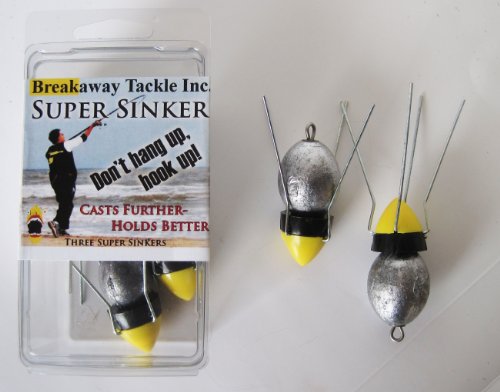 mono-filament. (Note: when going after bigger game fish you may want to use lighter strength line here, as a breakaway from the sinker) I use pyramid sinkers, they dig in well, and only big swell will move them on the bottom. For huge surf conditions there’s always a grabber sinker with bendable spidey arms, those baby’s sit, but can be a handful to cast!
mono-filament. (Note: when going after bigger game fish you may want to use lighter strength line here, as a breakaway from the sinker) I use pyramid sinkers, they dig in well, and only big swell will move them on the bottom. For huge surf conditions there’s always a grabber sinker with bendable spidey arms, those baby’s sit, but can be a handful to cast!
Here’s How it Works
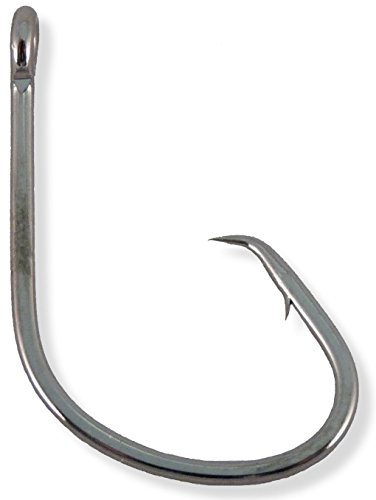 Your main line runs freely through this swivel and is tied to a swivel on the leader, which is heavier weight. The basic example I use all the time would have a 25 pound main line mono, with a 25 pound section to the sinker, and a 35 pound leader to the hook. The bigger the fish, the heavier the leader. For game fish and sharks you’ll need a steel leader.
Your main line runs freely through this swivel and is tied to a swivel on the leader, which is heavier weight. The basic example I use all the time would have a 25 pound main line mono, with a 25 pound section to the sinker, and a 35 pound leader to the hook. The bigger the fish, the heavier the leader. For game fish and sharks you’ll need a steel leader.
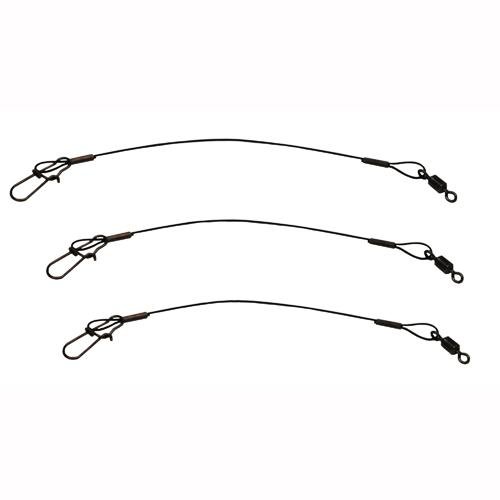 Circle hooks work very well here, you don’t have to set them hard, and they very seldom get swallowed by the fish, so if tag and release is your preference this works very well as they are easier to get out of the fish.
Circle hooks work very well here, you don’t have to set them hard, and they very seldom get swallowed by the fish, so if tag and release is your preference this works very well as they are easier to get out of the fish.
Fine Tuning for Different Surf Conditions
Leader length is going to be dependent on the depth of water and position in the surf zone, shorter in shallower water, longer in deeper or more turbulent water. We want to position the bait above the sand, and out of the bottom zone so the fish can see it, presented as naturally as possible. Remember, the longer the leader, the more difficult the cast, and the shorter the range you will get out into the surf line.
Here’s What the Fish Finder Rig Looks Like
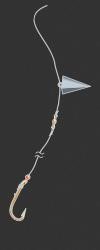
Swivel between main line and leader, weight slides on main line
Do it Yourself or Buy it Made Up?
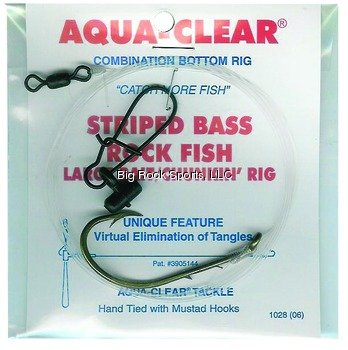 So, this all looks sweet and easy to set-up, (or you can just buy the rig set up and ready to go), what bait works the best you’re asking? Here’s where your local knowledge and a little research will close the deal, what are you aiming to hook up, and what do they eat, in this surf zone? I like sand fleas, (small intertidal crabs), or abalone or any local shellfish baits. For heavier or live baits mullet or similar is always a winner.
So, this all looks sweet and easy to set-up, (or you can just buy the rig set up and ready to go), what bait works the best you’re asking? Here’s where your local knowledge and a little research will close the deal, what are you aiming to hook up, and what do they eat, in this surf zone? I like sand fleas, (small intertidal crabs), or abalone or any local shellfish baits. For heavier or live baits mullet or similar is always a winner.
Extending the Rig Capabilities
Remember; this rig is really good for running live bait, no sinker drag on the line to alert the fish as they take the bait!
(We’ll have more about specific live bait rigs in a future post)
The Hi-Lo Or Drop Loop Set-up
So What Does a Hi-Lo Rig Look Like?
The second surf fishing rig uses an end sinker, with two hooks suspended on the line, one about 30cm from the sinker (bottom), and the second about 30cm above the first. About 20 to 30cm above that is a swivel, and your main line is tied to that.
Here’s How it Works
 The thinking here is two hooks are better than one. We are also covering two zones of fishing here, on the bottom; remember the line angle to rod tip, the bait is not actually going be 30cm above the bottom; and then another foot or so above that.
The thinking here is two hooks are better than one. We are also covering two zones of fishing here, on the bottom; remember the line angle to rod tip, the bait is not actually going be 30cm above the bottom; and then another foot or so above that.
Hooks used are the same as above, the only other special tip here is to use hooks with a straight, not offset eye. The dropped eye hooks tend to snarl or tangle the line in rough water and during casting.
Do it Yourself or Buy it Made Up?
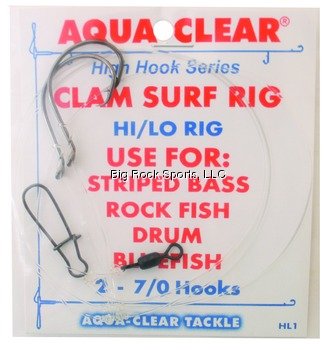 This is a classic fixed tackle rig, easy to understand, easy to rig, (or you can just buy the rig set up and ready to go), and it will feel familiar in action and sensation to other rigs you’ve perhaps used before. Just with double the opportunity.
This is a classic fixed tackle rig, easy to understand, easy to rig, (or you can just buy the rig set up and ready to go), and it will feel familiar in action and sensation to other rigs you’ve perhaps used before. Just with double the opportunity.
Sinkers or fishing weights are sometimes made of lead and they are usually pyramid type as above, but in gentle surf conditions, or on shallow banks, bullet style bank sinkers can be used if less weight is required. Just a reminder to be careful when using lead sinkers or weights since it can be dangerous to you.
Fine Tuning for Different Surf Conditions
This rig has one big advantage over the fish finder set-up above; and also one big disadvantage in comparison.
The advantage is that the weight is fixed, and consequently the rig is easier to cast, and will give you a better range, even with the additional mass of two hooks and baits. Because there is no extended leader, with free sliding bottom weight, the rig can be pulled up closer to the rod tip eye, and a stronger cast is possible.
The disadvantage is that the weight is fixed, (yes, that was intentional), fixed weight means you need to keep your rod tip at mid height, with some tension in the line, and set the hook hard when you feel the fish take the bait.
Here’s What the Hi-Lo Rig Looks Like

Swivel with double hook loops on line to sinker
Bait for this rig; pretty much same as for the fish finder rig above, aside from live (running bait) obviously.
Mullet or other bait-fish chunks, or prawn/shrimp, or local shellfish/abalone. Popular in the southern oceans is a cocktail combining shellfish with squid or octopus strips tied together with cotton thread on the hooks.
Extending the Rig Capabilities
This rig is a really good all beach, all season set-up. The bread and butter of the effective surf fishing rigs. Make sure you experiment with different strength leaders, and the line spacing between the hooks for the distance out in the surf, and the line angle to rod tip. The greater the angle, the higher the hooks will be in the water, and vice versa.
The Breakaway or Sacrificial Rig Set Up, aka Bank Weight Rig
So what does a Breakaway rig look like?
 The third surf fishing rig uses an end bullet sinker, with hook on a leader line, and a weaker line to the sinker.
The third surf fishing rig uses an end bullet sinker, with hook on a leader line, and a weaker line to the sinker.
Here’s How it Works
This rig is as commonly used as the Hi-Lo rig because you need this anywhere there is bottom structure, like rocky ridges or reefs in or between the surf lines. There is nothing more frustrating than hooking a good hard running fish, and then have the rig bottom-foul on rocks, allowing your fish to run to fight another day!
This rig is set-up with a two way swivel, and a straighter profile sinker to attempt to avoid the calamity described above. It’s simple really; you want to lose the sinker and its connection if fouled, and keep the hook and leader. (with the fish still hooked if possible).
Similar to the Hi-Lo rig, we use a triple or 3 way swivel. Main line is tied to the top eye of the swivel, leader (either mono-fil or steel trace or wire) is tied to the side eye of the swivel, and is usually about 30 to 40cm long.
Tie a 50cm piece of lighter strength line to the bottom eye of the swivel and attach (tie or clip) a bank sinker to the end.
Important Trick
Remember, the trick here is to buy a small reel of cheap mono filament line of about a third less strength than your main line; so if main line is 25 pound breaking, then the sinker should be attached with 18 pound breaking line. Too weak a line, and you’re going to lose a lot of sinkers, too strong a line and you’re going to lose a lot of fish!
Here’s What the Breakaway Rig Looks Like

Triple swivel with leader to hook, and weaker line to sinker
Do it Yourself or Buy it Made Up?
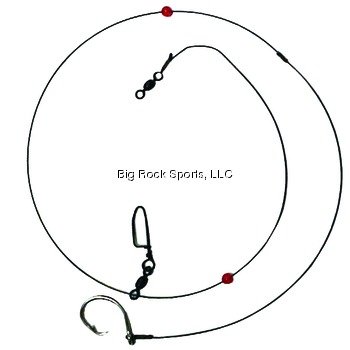 This rig is easy to set up, (or you can just buy the rig set up and ready to go), and you can experiment again with size of sinker, length of leader, and size of hooks, just like in the two previous set-ups.
This rig is easy to set up, (or you can just buy the rig set up and ready to go), and you can experiment again with size of sinker, length of leader, and size of hooks, just like in the two previous set-ups.
Bait for this rig; again, pretty much the same as for the two above, with the exception of the live bait scenario.
Extending the Rig Capabilities
This rig is the last of the surf fishing rigs in this post; its the bread and butter rig for any beach with structure (rocks or other) on the bottom. Its easy to use, easy to set-up, easy to modify and experiment with. Like the two previous rigs above, these should all be in your tackle box when you next hit the beach, I am sure that they will work as well for you as they have for me, and my Dad, and his Dad…
Well, you know the story now, make it your own.
Happy fishing!
As an Amazon Associate, Fishermen's Angle earns from qualifying purchases. We get commissions for purchases made through links in this post.
